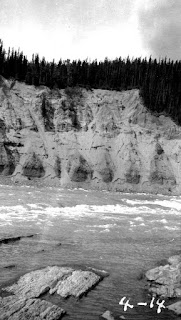Day 22. Excerpts from the Journals of Alexander MacKenzie on his Voyage of Discovery to the Pacific Ocean via the Peace River.
“We were alarmed this morning at break of day, by the continual barking of our dog, who never ceased from running backwards and forwards in the rear of our situation; when, however, the day advanced, we discovered the cause of our alarm to proceed from a wolf, who was parading a ridge a few yards behind us, and had been most probably allured by the scent of our small portion of fresh meat.”
As noted before, there are dangers lurking everywhere on this Voyage.
“The weather was cloudy, but it did not prevent us from renewing our progress at a very early hour.”
Even though he lost the log book with his course directions and miles traveled, the “considerable river” he passed here is known today as Clearwater Creek.
Picture 2. Top of the map is North. They are heading west, on a river channel that of course is now submerged under the lake shown on this modern map of the area. The Clearwater is the large arm of water, lower right corner, which will be on his left.
“A considerable river appeared from the left, and we continued our course till seven in the evening, when we landed at night where there was an Indian encampment.”














